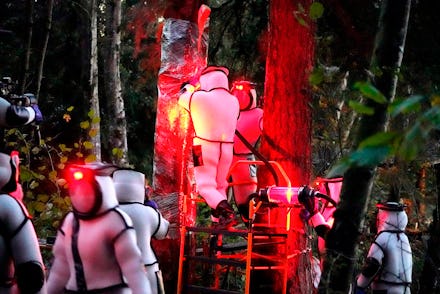The first hive of murder hornets found in the U.S. housed a staggering 200 queens

Officials in Washington State announced this week that they have for the first time found a murder hornet nest in the United States. About the size of a basketball, the nest was housing an absolutely horrifying 200 queens.
200! In a single nest! That is simply too many queens. Thankfully, they're all dead now.
But just because entomologists were able to find and murder this specific hive of murder hornets doesn't mean there aren't others buzzing around out there. In fact, the sheer number of hornets inside this relatively small nest has officials worried about the possibility that there are others like it out there.
"When you see [...] a relatively small nest like this able to pump out 200 queens, it does give one a little bit of pause," WSDA entomologist Sven-Erik Spichiger said in a virtual press conference.
How we got here
As you might recall, murder hornet first burst into the nation's nightmares back in May. The bugs are two-inches in length and fly around decapitating hardworking honeybees to steal their larvae for food. The WA State Department of Agriculture (WSDA) asked the public to keep an eye out for them so their exterminators could locate the hive.
Months passed with no word. Officials were able to narrow down the possible location to an area near Blaine, a town near the Canadian border, but they were becoming anxious. It was getting closer to the hornets' "slaughter phase," a period of time where the bugs go into a frenzy, wiping out entire hives of honeybees for food within hours.
Thankfully, entomologists were able to capture live hornets and stick itty-bitty tracking devices on their bodies. After a bit of trial and error, they were able to follow the tagged bugs back to their nest in late October.
Inside the murder hornet hive
The hive housed a veritable city of bugs. There were 190 larvae in total, 108 pupae that were almost all queens, 112 workers, and 76 virgin queens ready to leave the nest to start their own.
"We got there just in the nick of time," Spichiger said in the press conference. But their work isn't over yet. There are still hornet sightings in the area, which means there's probably another nest to find. And, if the contents of the first nest are any indication, it's important to find it quickly.
"We believe there are additional nests," Spichiger told the media. "There is no way to be certain we got them all."
The next chapter of the hornet saga
The good news is, so far, the hornets appear to be localized in the border area between Washington State and British Columbia, Canada. Spichiger doesn't believe many queens left the nest before they got to it, but there's definitely a chance they'll find new hives come spring.
"It's possible some [queens] emerged before we did the extraction," he admitted. "There is no way of knowing how many more." Exterminators already found three queens in the same area after they removed the first nest.
But WSDA isn't letting the numbers get to them. "Frankly, we are encouraged because of the number of queens we were able to count and kill," Spichiger said.
Yes, off with their heads!